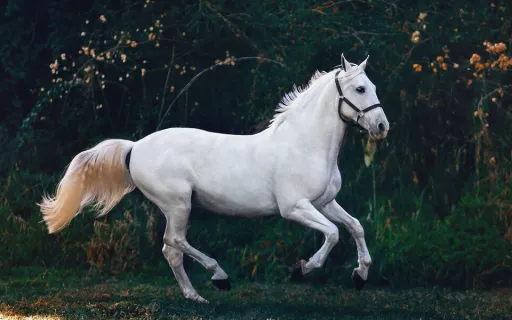The horse is naturally a herbivore, which means its instincts are programmed for “flight.” That’s why even a well-trained horse can sometimes be unpredictable, so it’s good to remember a few basic rules we should always follow when dealing with horses.
Do not approach a horse from behind
If you come up behind a person who doesn’t know you’re there, they’ll naturally be startled, but at most they’ll just flinch or shout. It’s the same with horses, except that in the best case they’ll jump aside. In the worst case, they may kick you or even try to run off and injure themselves in the process.
If there’s no other way to approach the horse, at least make your presence known with a greeting, call its name, or whistle. The important thing is that the horse knows you’re there — that’s the best way to avoid unpleasant surprises.
The safest way to approach a horse is from the front or side, so that the horse can see you and there’s no element of surprise.

No running or sudden movements near a horse
This point is closely related to the previous one. Try to stay as calm as possible around horses. They are sensitive animals that react strongly to their surroundings. In riding schools, most horses are used to noise and sudden movements, but don’t rely on that — especially if you’re meeting a horse for the first time.
Around horses, do everything smoothly, without unnecessary sudden movements that might startle them. Speak naturally and don’t shout unless absolutely necessary.

Do not feed strange horses
In many cases nothing happens if you pick some grass and give it to a horse. But you don’t know that horse or its character — it could accidentally bite you.
Never feed a horse hard bread unless its owner allows it. You don’t know if the horse is on a special diet for health reasons. Poorly dried bread can also cause serious problems, such as colic.
If you can’t resist offering something, give it some grass. An apple or a carrot is also fine, but don’t overdo it — one or two pieces are enough.

Watch its expressions
From a young age, thanks to socialization, we subconsciously learn to read nonverbal gestures in people to predict their mood or behavior. It’s the same with animals. When you approach a horse, pay attention to its expression to avoid unnecessary accidents. Of course, most people don’t know how to read a horse’s expressions — why would they? So here are three basic ones to get you started.
The easiest thing is to look at the horse’s ears — they’ll tell you best whether you can approach or pet it.
- A horse with ears pricked forward is alert and curious about something nearby. You can calmly approach, and if its expression doesn’t change, you might even pet it.
- A typically relaxed horse has its head slightly lowered and ears relaxed, pointing slightly to the sides. Sometimes they flick if the horse hears something. You can approach such a horse safely, just make sure it notices you.
- A horse that doesn’t like your presence will give clear warning signs. It’s tense, stands upright, and its ears are pinned back. Stay away from such a horse and don’t approach it at all.

Dogs and horses
Animal friendships can be beautiful to see. But behind that is a lot of work by the owners to make sure this coexistence works smoothly. If your dog is used to horses and the horse is used to dogs, there usually won’t be a problem.
If not, never let your dog run loose near a horse. Sadly, many dogs have been injured or even killed because of careless owners. When you’re outdoors with a free-running dog, always watch the surroundings — that rule applies in every situation. This way you can avoid not only trouble with horses but also dog fights. Most importantly, teach your dog recall before ever letting it off-leash. That command can save you from many unpleasant situations.
If you take an inexperienced dog into the stables, first ask the horse’s owner if the horse is used to dogs. Then let the dog approach slowly on a leash. If it doesn’t try to attack the horse, you may let it go, but always keep it under supervision.

Crawling under a horse
It may sound funny, but you’d be surprised how often small children crawl under horses and start scratching their belly. For adults this is an obvious no, but children who bond with horses may start to think nothing can happen to them. It may seem like a harmless thing, but it can end badly. That’s why it’s important to constantly remind children that a horse is a large animal that deserves respect, even if there’s no need to fear it.
If a child wants to pet a horse, first make sure the horse is suitable for it. Then you can allow it. The best spots to pet a horse are the head, neck, or back.

Do not kick horses
Yes, you read that right! In some stables you might see people punishing horses by kicking them, for example in the shoulder. They often justify it by saying that this is how horses naturally communicate, which is partly true. But the horse knows very well you’re not another horse. If you kick it, it will likely copy your behavior.

Whip use
The whip is definitely not meant to punish horses! Don’t use it for that purpose, even if your instructor says otherwise. The whip should act as an extension of your arm to help you coordinate while riding.
From the last two points, remember one principle: Never physically punish a horse! Apart from the fact that a horse is a living being, keep in mind it’s much stronger than you. If it reacts against you — by kicking or trying to bite — the safest response is simply to step away.

Never wrap the lead rope around your hand
You may find yourself leading a horse. Hopefully there will be someone experienced to explain the rules. But remember this: never wrap the lead rope around your hand. If the horse bolts, your hand could get trapped in the rope as the horse runs away.
Also, when leading, never walk directly in front of the horse — it could bite or jump into you if startled. Always walk beside the horse with a slightly loose rope.

Don’t throw the reins like in the movies
In films, especially westerns, you often see riders throwing the reins to make the horse move or speed up. Movies are movies, and that’s where it should stay. Don’t copy the actors — it doesn’t work. The only thing you’ll achieve is an annoyed horse, because by jerking its bit you’ll cause it pain. Repeated often enough, the horse may stop responding to the bridle altogether.
It’s better to listen to your trainer or the horse’s owner — they’ll explain how to handle the reins properly.

Summary of the most common beginner mistakes with horses
- Do not approach a horse from behind
- No running or sudden movements near a horse
- Do not feed strange horses
- Watch its expressions
- Dogs and horses
- Crawling under a horse
- Do not kick horses
- Whip use
- Never wrap the lead rope around your hand
- Don’t throw the reins like in the movies
So, do you feel more confident around horses now? Do you think we forgot something? Let us know in the comments!

